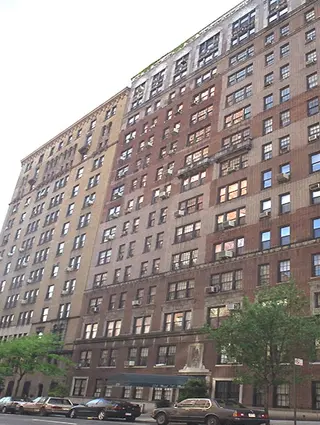 Carter Horsley
Carter HorsleyDec 23, 2011
Carter's Review
Museums, art dealers and art collectors have long debated the merits of how to repair severely damaged works of art. For generations, it was customary for expert restorers to try their best to make the work look whole and disguise the repair, but modern conservators dislike such deception and prefer to make the repair quite obvious.
This was a handsome, Italian Renaissance-palazzo-style apartment building that was erected in 1925 and converted to a cooperative in 1980. The central part of its third floor façade, however, shows dramatic evidence of a major alteration around six windows where the masonry, and possibly other architectural detailing have been replaced with a stucco-like flat surface whose light color contrasts boldly with the rest of the building.
Given the popularity in architectural circles of Post-Modern and Deconstructivist flourishes, one is tempted to conjur all sorts of wild treatments for this barren patch. Perhaps it should be a violet terracotta surround, or a chrome reveal. Whatever it should be, it should not be left as is.
Architecture is the most public of all the arts and honesty has its place, but shoddy workmanship or unsympathetic design do not and this patch is an unfortunate eyesore on an otherwise nice building on a very fine block.
The 14-story building has only 49 apartments and lovely wrought-iron window grills on its first floor with a canopied entrance with an attractive fanlight leading to a small, step-up lobby. The building has a doorman and sidewalk landscaping like many other pre-war buildings on this very pleasant and rather quiet street, one of the nicest on the Upper West Side.
The building permits protruding air-conditioners and has no health club and no garage.
The east end of this quiet street faces Manhattan Square, the large park in which the American Museum of Natural History stands.
The building's central Upper West Side location is very close to famous stores along Broadway and a delightful stretch of sidewalk caf¿s a few blocks north on Amsterdam Avenue. There is good public transportation and this area is convenient to the various amenities of the Lincoln Center District about a dozen blocks to the south.
Carter B. Horsley

- Co-op built in 1925
- Located in Broadway Corridor
- 49 total apartments 49 total apartments
- 10 recent sales ($1.9M to $3.5M)
- Doorman
 6sqft delivers the latest on real estate, architecture, and design, straight from New York City.
6sqft delivers the latest on real estate, architecture, and design, straight from New York City.
